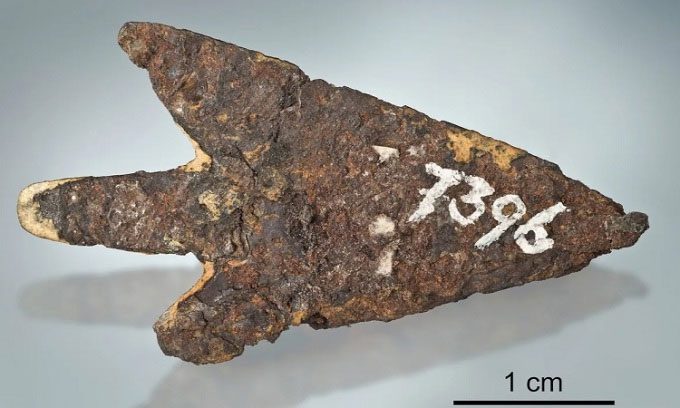After scanning an area the size of Switzerland for meteorite artifacts, researchers discovered a tip of an arrow forged from extraterrestrial metal.
Describing the finding in a newly published study in the Journal of Archaeological Science, the research team from the University of Bern explained how they searched the archaeological collection around Lake Biel and accidentally found the arrowhead. Weighing 2.9 grams and measuring 39.3mm in length, the arrowhead originated from the Mörigen settlement during the Bronze Age, existing between 900 and 800 BC, as reported by IFL Science on July 28.

The arrowhead may be forged from a meteorite 1,600km away. (Photo: Thomas Schüpbach/Journal of Archaeological Science).
The meteoritic nature of the iron used to forge the arrowhead was confirmed by the presence of aluminum-26 isotopes, which only appear in objects from beyond Earth’s atmosphere. The research team also identified that the arrowhead contains a special alloy of iron and nickel, which is also found in meteorites. Residue from an ancient adhesive, likely birch tar, was left on the object, suggesting that the arrowhead may have once been attached to a long shaft. However, the research team is unclear whether the weapon was used for hunting or combat.
Since Mörigen is located less than 8km from the Twannberg meteorite site, this meteorite seems to be a clear candidate for the iron used in the arrowhead. However, after analyzing the artifact, the research team noted that the nickel and germanium densities did not match those of the Twannberg meteorite. Upon further examination, they determined that the weapon was forged from a meteorite classified as IAB. The mineral composition indicates that the meteorite weighed at least two tons before entering the atmosphere.
Among the IAB meteorites from Europe, three meteorites with a chemical composition matching the Mörigen arrowhead include Bohumilitz (Czech Republic), Retuerte de Bullaque (Spain), and Kaalijarv (Estonia). Only the Kaalijarv meteorite fell to Earth during the Bronze Age and is the most likely candidate for the source of iron in the arrowhead.
Estimated to have fallen to Earth between 1870 and 1440 BC, fragments of the Kaalijarv meteorite could be scattered among local communities. Given that Mörigen is about 1,600km from Kaalijarv, the research team concluded that their findings demonstrate that meteoritic iron was used and traded during the Bronze Age in Central Europe.


















































